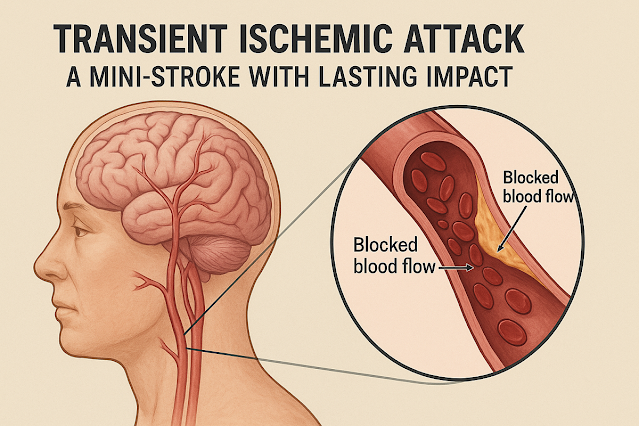Discover how transient ischemic attacks (TIAs), or "mini-strokes," can lead to long-term fatigue. Learn symptoms, risks, and recovery strategies that matter.
 |
| What You Need to Know About Transient Ischemic Attacks: Fatigue Can Last a Year or More |
Highlighted :
>Transient ischemic attacks occur when there is a temporary blockage to the brain’s blood supply, often caused by a clot or plaque.
>TIA symptoms may resolve quickly, but they signal serious underlying cardiovascular risks and should never be ignored.
>Research about the potential long-term impact of transient ischemic attacks is ongoing, revealing that even brief events can lead to lasting health issues.
>A recent study has found that people who experience a transient ischemic attack, or ‘ministroke,’ can experience fatigue for as long as a year afterwards, challenging the notion that TIAs are harmless. 📚 Source
What You Need to Know About Transient Ischemic Attacks:
What You Need to Know About Transient Ischemic Attacks: Fatigue Can Last a Year or More Understanding Transient Ischemic Attacks-A transient ischemic attack (TIA), often called a "mini-stroke," is a brief episode in which the brain's blood supply is temporarily blocked, causing stroke-like symptoms that resolve within 24 hours.
While they might seem harmless due to their short duration, TIAs can be a crucial warning sign of future, more severe strokes and long-term complications.T
Key Point: ransient ischemic attacks occur when there is a temporary blockage to the brain’s blood supply..📚 Source
What Causes a Transient Ischemic Attack?
TIAs are typically caused by a blood clot or plaque that temporarily obstructs blood flow in the brain. Unlike a full-blown stroke, the blockage in a TIA resolves quickly without permanent damage. However, the root causes—such as atherosclerosis, hypertension, or atrial fibrillation—need immediate medical attention.
Key Point: Even though symptoms disappear quickly, the underlying cardiovascular issues remain and must be addressed. 📚 Source
Common Symptoms of a TIA
TIA symptoms are similar to stroke symptoms but temporary. They include:
- Sudden numbness or weakness in the face, arm, or leg—especially on one side
- Sudden confusion, trouble speaking or understanding
- Sudden trouble seeing in one or both eyes
- Sudden trouble walking, dizziness, or loss of balance
These episodes typically last minutes to hours and are often dismissed by patients, which can delay crucial interventions.
Key Point: Never ignore stroke-like symptoms, even if they go away quickly.
Long-Term Impact of TIAs: What the Research Shows
Although a TIA doesn't usually cause permanent brain damage, ongoing research has shown potential long-term impacts. From cognitive decline to chronic fatigue, TIAs may leave lingering effects that influence quality of life months or even years later.
Key Point: Research about the potential long-term impact of transient ischemic attacks is ongoing, indicating these "mini" strokes can have major implications .📚 Source
What Causes Post-TIA Fatigue?
The mechanisms behind post-TIA fatigue aren't entirely understood, but researchers believe several factors are involved:
- Inflammation in the brain following the event
- Psychological stress and anxiety after experiencing a serious health scare
- Microvascular damage not visible through conventional imaging
- Disrupted neural pathways that affect energy regulation
Key Point: Post-TIA fatigue could be a result of neurological and psychological aftershocks from the event.📚 Source
Fatigue vs. Depression: Know the Difference
Fatigue after a TIA can often be mistaken for depression, and vice versa. While the two conditions can co-exist, it's important to distinguish between physical tiredness and mood-related issues to provide the most effective treatment.
- Fatigue often improves with rest
- Depression-related fatigue may persist regardless of sleep or rest
Key Point: Accurate diagnosis of post-TIA fatigue is essential to avoid mismanagement and inadequate care.📚 Source
Who Is at Higher Risk for Long-Term Fatigue After a TIA?
Certain populations are more vulnerable to post-TIA fatigue, including:
- Older adults
- Individuals with a history of mental health issues
- Patients with comorbid conditions like diabetes or heart disease
- People with poor social support systems
Key Point: Demographics and pre-existing conditions may influence the severity and duration of post-TIA fatigue. 📚 Source
Managing Fatigue After a TIA: Tips and Strategies
There’s no one-size-fits-all solution, but the following strategies may help:
- Structured rest and nap schedules
- Light physical activity to boost energy
- Cognitive-behavioral therapy (CBT)
- Hydration and nutrition to support brain health
- Regular follow-ups with neurologists and therapists
Key Point: Lifestyle adjustments and medical support are critical for managing long-term fatigue. 📚 Source
Why Recognizing TIA Symptoms Early Matters
Identifying a TIA early and seeking immediate care can prevent a full stroke. According to the American Stroke Association, up to 1 in 3 people who have a TIA will eventually have a stroke, often within a year.
Key Point: Timely action after a TIA can save lives and reduce complications. 📚 Source
Final Thoughts: Don’t Underestimate a Mini-Stroke
A TIA may be transient, but its implications are far-reaching. From serving as a warning sign for major strokes to causing long-term symptoms like fatigue, these events demand serious medical attention and lifestyle changes.
Key Point: TIAs are not harmless—they're a wake-up call for better brain and heart health.📚 Source
Conclusion: Be Proactive, Not Reactive
Awareness, early detection, and consistent follow-up care are the best ways to mitigate the risks associated with TIAs. If you or a loved one has experienced symptoms, don’t wait—seek medical attention immediately and prepare for a comprehensive recovery plan.
Key Point: Early intervention and long-term management are key to improving quality of life post-TIA. 📚 Source
______________________________________________
Tag :#TransientIschemicAttack #MiniStroke #StrokeAwareness #TIARecovery

